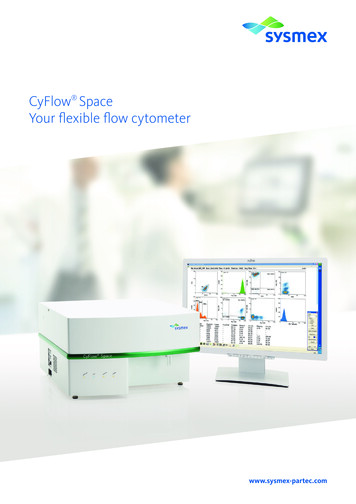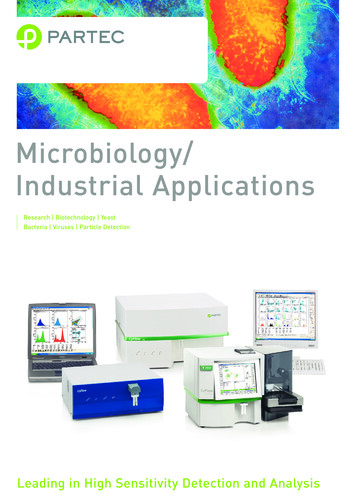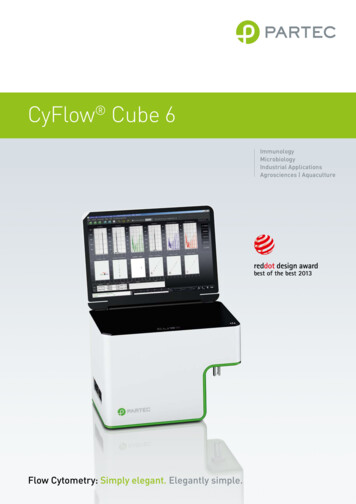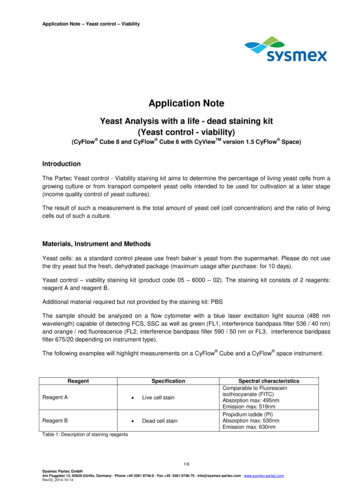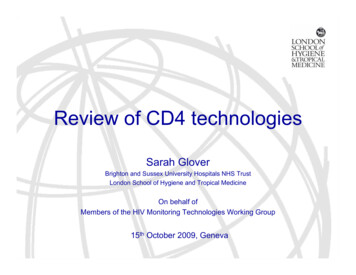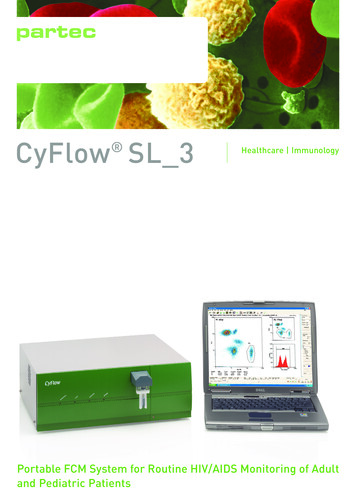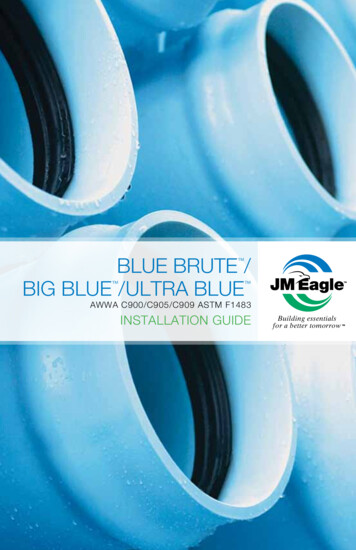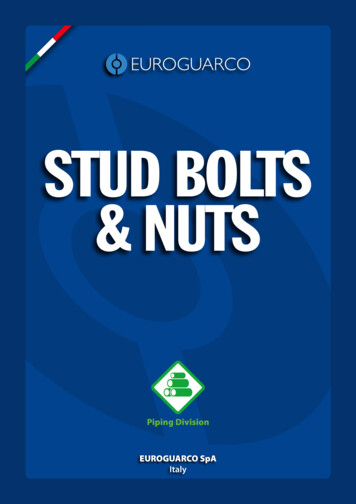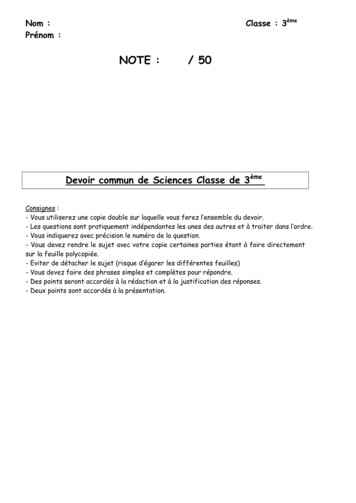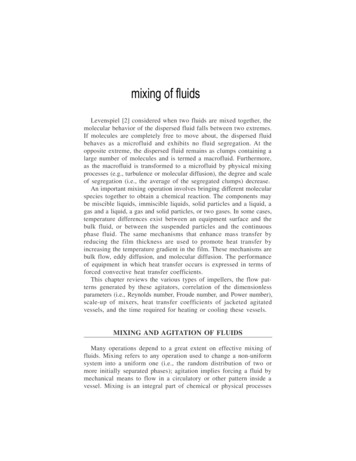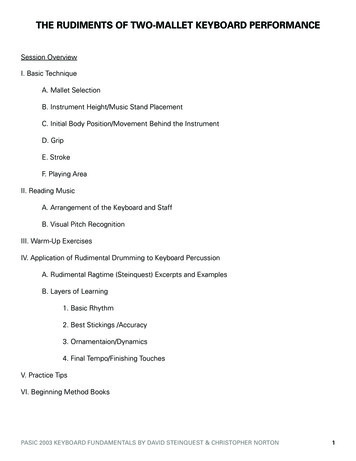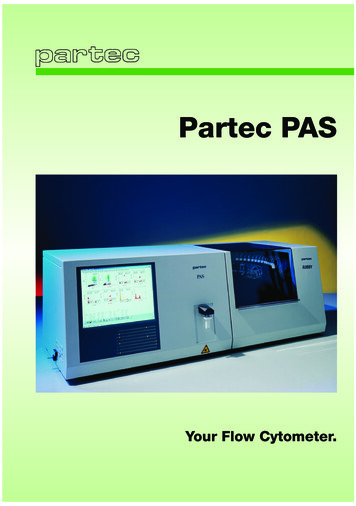
Transcription
Partec PASYour Flow Cytometer.
The Challenge.New sophisticated applications and increasing requirements for reliable routineresults in the shortest possible time continue to impose a challenge for flow cytometry instrumentation, automation and software. our ExperiencePartec, pioneer in flow cytometry for morethan 30 years, contributes to these requirements with the new generation of WindowsTM-based PAS Particle Analysing Systems. An innovative computer controlledflow system, the modular optical systemwith advanced photomultiplier tubes for alloptical channels, recently available newcomputer and electronic technologies, forexample new fast and precise 16 bit analog-to-digital converters, and the possibility for microsecond realtime data acquisition using the WindowsTM operating systemwere combined in a completely new instrument and software design.All flow cytometry applications inhealthcare, microbiology, food and cosmetics control, plant and animal cell analysis benefit from the unique features of thisdesign - and this brochure tries to give ashort overview about some of the strikingfeatures and results with the new PAS.We invite you to take part in thefascinating investigations the PAS offers ustoday. And we guarantee to offer you qualified scientific and technical applicationsupport and service, now and in the future.Partec Headquarters in Münster, GermanyThe PAS Particle Analysing System Your Fully Equipped Bench-Top FlowCytometerAvailable with a range of light sources, e.g. Argon lasers,ranging from 20 mW to 100 mW, 100 W mercury UV lamp,25 mW red laser diode and solid state lasers, and 1 to 8parameters, the optical configuration of the PAS is the optimum prerequisite for routine cell analysis applications,covering microbiology and small particle analysis, 4colour immunophenotyping, precise volumetric absolutecounting and DNA analysis. New upcoming applications,employing multiple light source excitation with UV and lasers and involving high precision DNA analysis with DAPIor Hoechst together with surface markers, e.g. for no-lyseimmunophenotyping techniques, are now available withthe PAS.PAS-III: Expandable by many light sourcesAdditional larger external laser sources like NdYAG,HeCd or HeNe lasers can be added to the modular opticalsystem by means of a stable optical bench support forboth the instrument and extra light sources, thus offering acompact and rigid solution for the most demanding applications.Eight fully parallel optical parameters, each with its ownphotomultiplier tube (PMT), including the forward scatterPMT, give you the most flexible choice and offer the bestsensitivity and enough space for future applications. Dueto the built-in WindowsTM computer and ergonomic TFTLCD display, fully equipped and side-by-side with theRobbyTM sample automat and autoloader, the PAS requires no more space than a normal laboratory table and anormal electrical line connection, thus reducing your laboratory requirements to a minimum. By featuring standardized PC-computer components, the PAS can be directlyintegrated into your laboratory information system via barcode reader, automated Word / Excel reports and a fastEthernet network connection.
The FlowThe heart of the PAS is the unique quartz flow cuvette, ensuring that particles cross the UV and visibleexcitation light with best possible precision, well oneafter the other. The design of the flow cuvette incorporates more than 30 years of experience in handling fluids with sub-micrometer and nanoliter precision. Thanks to the optical and mechanical precisionof the flow cuvette, superior results are guaranteedfor all parameters, e.g. coefficients of variation (CVs)of better than 1% with DAPI staining - a prerequisitee.g. for high precision DNA measurements for tumoror chromosome analysis.The sample is transported with help of a computer controlled digital syringe pump, part of avirtually cross-contamination-free fluid system( 0.1% cross-contamination). This system allowscontinuous flow absolute counting, displaying concentration results a few seconds after starting asample analysis.The „heart“ of the PAS: the synthetic quartz flow cuvette.Quartz optics guarantee high transmission for UV applicationswithout temporal degradation.Optics and Light SourcesThe 8-parameter optical system features a clear optical pathway, built upon Partec’s legendary opticalcubes. All optical elements, including the UV mercury lamp and the lasers, are mounted onto a singlerigid optical bench, which guarantees optimum mechanical stability and avoids problems when movingthe instrument to another place.By means of the built-in colour CCD camera, thestability of the sample flow and the sorting process(in conjunction with the closed system piezo-sorter)can be controlled in a video flow monitor on the LCDscreen.For most applications, you will not need tochange the standard configuration for side scatter(SSC), forward scatter (FSC) and 4-colour fluorescence analysis. The standard setup is optimized forall common dyes, e.g. FITC, GFP, PI, PE, PE-CY5,SR, APC, FDA, DAPI, and Hoechst. In its standardconfiguration, the PAS allows spatially separated 2wavelength excitation analysis with UV laser, laserdiode Ar laser or UV laser diode, optimized bydiaphragms in several intermediate image planes.However, the modular optical system lets youeasily configure the PAS for special applications andother fluorochromes - simply by changing dichroics/filter blocks and diaphragms without time-consuming readjustments.For your routine and new applications, Partec offers you the assistance you need.The PAS integrates anAr-laser, red laser diode, andUV mercury arc lamp.Modular PAS optics built upon optical cubes for 8 parameters.For the PAS-III external lasers, e.g. NdYAG, HeCd or HeNe, canbe mounted onto a common rigid support.
Computer and ElectronicsEach of the optical channels is equipped with an independent processor controlled pulse analyser forparallel pulse processing in order to minimize signallosses due to coincidence and dead-time effects.The logarithmic amplifiers, specified for a 6-decaderange, provide safe dynamics for 4-decade operation. 16 bit (65536 channels) analogue-to-digitalconverters for each parameter are the fundament forsoftware-based colour crosstalk compensationalgorithms and other numerical operations, e.g.fluorescence ratio measurements, without artifacts.The computing power of the Pentium allows signal analysis, processing, and display of each eventgenerated by a particle in real-time, while offeringthe convenience of the 32 bit WindowsTM operatingsystem. Real-time is a prerequisite for precise volumetric absolute counting and high speed and highpurity sorting based on complex software-gates.The PAS is equipped with a 650 MB CD-Writer forconvenient data storage and Ethernet networkconnection with 10 MB/s and 100 MB/s for an easyconnection to your laboratory information system(LIS).Built-in CD-Writer, Ethernet network connection and BarcodeReader facilitate data archive and transfer to laboratoryinformation systems.FloMax SoftwareThe WindowsTM FloMax software integrates instrument control, including acquisition, cell sorting, onand offline data analysis into one single softwarepackage. Ready prepared and freely adaptable instrument settings and panels facilitate switchingbetween different applications. FloMax is optimizedfor microbiology analysis, immunophenotyping, cellcycle, DNA ploidy, and scientific flow cytometricanalysis.Data is always stored as original data in FCS flowcytometry standard file format for easy exchangewith other analysis software.One of the unique features is the on- and offlinecolour crosstalk compensation of the spectral overlap of fluorescence from simultaneously analyseddyes. The N-colour compensation algorithm allowsa correction of the crosstalk between any parameters without need to rerun a sample.FloMax optimally supports the volumetric absolute counting feature of the PAS, displaying particleconcentrations for any subsets of cells, even if defined by a gate at a later time after the acquisition.The FloMax Panel system allows automatedanalysis of repeating sample series employing different dyes or instrument settings.The FloMax Report system generates easy-toadapt result reports based on Microsoft Word templates (.dot - files) or Excel Macros written in VisualBasic.FloMax graphical N-colour crosstalk compensation supportsmatrix-based on- and offline adjustments at any time withoutneed to rerun samples.The flexible multi-tube panel system of FloMax automatesroutine processes.FloMax Report generates automated single or multi-tube paneland measurment series reports in Word or Excel.
True Volumetric Absolute CountingThe PAS analyses concentrations of any particlesubpopulations of interest using true volumetric absolute counting. This unique method is solely basedon the fundamental definition of a particle concentration c, namely the counted number N of particlesin a given volume V, c N / V. In the PAS, the volume is measured directly by mechanical means, rather than by calibration with expensive beads with a(sometimes doubtful) „given“ nominal concentration. Thus, the precision of volume measurement isdefined by a fixed mechanical design, eliminatingany errors related to varying bead concentrations.The PAS allows analysis of either a fixed volume asdefined by the distance d between two platinumelectrodes reaching into the sample tube with a given diameter 2r, or, alternatively, a volume of freechoice involving the digital sample speed control.Benefits of true volumetric absolute counting:i) digital volumetric precision by mechanicaldesign: better than 2% reproducibility, 5% precision,ii) no errors related to calibration,iii) no additional preparation time for referencebeads,iv) no expenses for calibration beads.Schematics of true volumetric absolute counting, based onreal-time acquisition and counting of the number N of particlespassing the flow cuvette and mechanical measurement ofvolume V.BioSafety Sample Portfor true VolumetricAbsolute Counting.Sample AutomationBarcodes are a significant automation component inmany routine laboratories. Today, due to the varietyof different systems, a flexible barcode system ismost important. The PAS Barcode supports all common barcodes used for laboratory automation. Barcode reading is well integrated into the software.Besides for identifying samples and reagents, barcodes also serve as a safe selection among predefined panel protocols or instrument settings.For optimum sample automation, the PAS can beequipped with the RobbyTM sample preparation automat and autoloader for carrousels of 36 sampletubes. Samples are prepared according to predefined protocols that can be freely adapted for specialpurposes. Controlled by the WindowsTM RobbyPrepsoftware, the preparation covers staining with up to16 reagents, incubation, sample shaking and cell lysis. The analysis of complete carrousels is automated by FloMax , which combines the panelsystem with the RobbyTM automat control.As a result, a fully automated process generatescomplete multi-page panel or routine series reportsin Word or Excel format.Full walk-away automation including staining, lysing andsample analysis by the WindowsTM controlled RobbyTM samplepreparation automat and autoloader.
Bacteria AnalysisFSC and SSC plots of spores and vegetative cells ofBacillus subtilis. Excitation with 488 nm by an argonlaser (20mW).Absolute counting and measurement of RFP-expression (FL2:orange-red) of an E. coli population after excitation by aNdYAG-laser (532 nm, 50 mW): 40% of the E. coli populationshow the red fluorescence due to RFP-expression.Yeast AnalysisMeasurement of GFP-expression (FL1 GREEN) of aSalmonella sp. population after excitation by an argonlaser (488 nm, 20 mW).DAPI (DNA, FL-IV) and nile red staining (neutral lipids, FL-III) ofbrewery yeasts after double wavelength excitation by HBOlamp (UV) and argon ion laser (488 nm, 20 mW).DNA Ploidy Analysis with DAPI and PITumor AnalysisCells of potato plant, 2n 4n, stained with PartecCyStain UV (DAPI).Mamma carcinoma biopsy laser scatter (488 nm, 20 mW) DAPI excitation by HBO lamp.Cell SortingSorting of lymphocytes - selection of the sort window(left) and reanalysis (right).Sorting of a granulocyte subset - selection of the sortwindow (left) and reanalysis (right).
Immunophenotyping: 6 parameter, 4 ColourFluorescence Analysis with ColorGatingNo-Lyse Leukocyte AnalysisSimultaneous analysis of four antibody surface markers byargon laser and red laser diode excitation.Dual wavelength excitation by UV lamp and laser. By usingDAPI as trigger signal, full blood analysis is limited to theleukocytes.CD34 Volumetric Absolute CountingCD4/CD8 Volumetric Absolute CountingRare event concentration analysis on CD34 cells.(patient sample).Routine concentration analysis on CD4/CD8 for HIVmonitoring.UV plus Ar-laser 2 Wavelength ExcitationPlatelet AnalysisSimultaneous analysis of DNA (DAPI) and antibody surfacemarkers.Supported by the use of a PMT for the FSC parameter, thesmall platelets (PLT) can be easily discriminated from redblood cells (RBC) in the scatterplot.Leukocyte Depletion Process Control Analysis of leukocyte concentration based on CyStain (DAPI ) staining and volumetric absolute counting. Due to the digitalnature (high signal to noise ratio) of the bright DAPI staining of the leukocyte nuclei, concentrations down to 0.01 cells/µl (10cells / ml) can be safely determined.
PAS SpecificationsGeneralCompact flow cytometer for automated sequential analysis ofsingle cells and microscopic particlesScatter particle size range 0.2 µm - 200 µmFluorescence sensitivity: 100 MEFS (FITC) or betterFluorescence resolution (CV): 1% or better (DAPI)Configurations with 1 to 8 optical parameters time parameterLight SourcesBuilt-in air-cooled Ar-ion laser with 20 mW at 488 nm (PAS andPAS-III) and 50 or 100 mW (PAS-III only) at 488 nm, 458 and515 nmHBO mercury arc lamp, 100 W, for UV excitation and other wavelengthsDiode laser 25 mW at 635 nm, temperature controlledDiode laser, 430 nmNdYAG 50 mW at 532 nmInstrument size PAS: 770 mm x 500 mm x 550 mm (WxHxD) Instrument size PAS-III: 1400 mm x 500 mm x 550 mm (WxHxD)Recommended laboratory table size (PAS): 1600 mm x 800 mmExternal lasers on optical bench support (PAS-III):HeCd 325 nm, 354 nmHeNe 30 mW at 633 nmOther lasers upon requestOpticsModular optical system with 1 to 8 optical parameters with selected PMTs with integrated electronic preamplifier for each parameter, including FSCStandard setup and filters for FSC, SSC, FL1-FL6Colour CCD camera for video flow monitorKöhler illumination by HBO lampUV transmitting quartz opticsStandard objective mount with high numerical aperture objective, high numerical aperture immersion gel coupling, e.g. fordetection of weak cytokines (option)Various intermediate image planes for optimized spatial filteringby diaphragmsFlow SystemSynthetic quartz flow cuvette for laminar sample transport withsheath fluidSample port with computer controlled BioSafety cleaning system, avoids sample droplets and minimizes cross contaminationTrue Volumetric Absolute Counting based on mechanical volume measurement, no need for reference particlesContamination-free computer controlled precision syringepump for sample transport and volumetric absolute counting,pump speed continuously adjustable from 0-50 µl / s, sheathfluid pressure continuously adjustable from 0-300 mbar, easilyaccessible 5 l sheath fluid and waste reservoirs with filling levelsensorsCell SorterClosed piezo sorting systemMinimizes sample hazardsAnalysis speed up to 15 000 particles / s, sorting speed up to500 sorted particles / s for sort purities 95% (depending onsample), video flow monitor for monitoring of sorting process easy and reliable sorting setup.Electronics and ComputerParallel signal processing for each of the optical channels withselectable linear, 3 or 4-decade logarithmic amplification (6-decade log amplifiers), pulse height, area and width analysis fordoublet dicrimination, 16 bit analog-to-digital converter, triggeron any parameter or all parametersUpgradable built-in industry standard computer, Pentium processor (at least 800 MHz), 128 MB RAM, 30 GB harddisk,built-in 15“ TFT LCD display, CCD camera video flow monitoron LCD window, external 17“ or 21“monitor for dual screensetup (option), 650 MB CD-Writer, 3,5“ Floppy Disk Drive,100 MB ZIP drive optional, keyboard, mouse, barcode reader,10 MB/s / 100 MB/s Ethernet connection, DeskJet colour printer, b&w or colour laser printer optional, printing via networkSoftwareMicrosoft WindowsTM 98 or 2000 operating system with full network support - Apple /Macintosh network connection optional32 bit WindowsTM FloMax software for routine and research applications1-8-parameter real-time data acquisition and analysisDual wavelength acquisition from spatially separated light sources with time-window delay-systemInternal floating point numerics with double precisionOne and two parameter histograms and dotplots64 - 32768 channels resolution for 1P histograms32/32 - 1024/1024 channels for 2P dotplotsMultiparameter N-colour crosstalk compensation, settings maybe corrected any timeMultiparameter ColorGatingRatio measurementDoublet discrimination based on pulse height, area and widthanalysisPeak and cluster analysis and statisticsRobbyTM sample automat controlDNA cell cycle analysisDNA peak analysisMultitube panel system with automated acquisitionFlow Cytometry Standard data format FCS 2.0 for storage oforiginal and evaluated dataStorage of gates and screen layoutAutomated data transfer of graphics, statistics and instrumentsettings to Word, Excel, other desktop publishing systems or laboratory information systems (LIS).Instruments, Reagents and AccessoriesPartec offers a broad range of instruments, protocols andreagents for microorganism detection, red blood cell lysing,DNA cell cycle and ploidy analysis, disposable CellTricsTM cellseparation filters, sample tubes for volumetric absolutecounting, UV objectives and more. Please inquire for anyinformation for your application.Robby sample automat and autoloader36 tube carrouselUp to 16 reagentsSample shakerWindowsTM RobbyPrep softwarePartec GmbHOtto-Hahn-Straße 32D-48161 Münster · GermanyTelefon (xx49) 25 34 8 00 80Telefax (xx49) 25 34 80 08 90E-Mail: info@partec.deInternet: http://www.partec.de
Partec, pioneer in flow cytometry for more than 30 years, contributes to these require-ments with the new generation of Win-dowsTM-based PAS Particle Analysing Sy-stems. An innovative computer controlled flow system, the modular o
